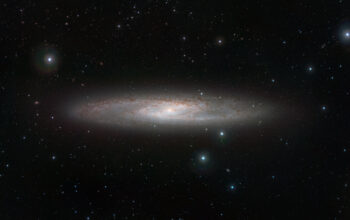Active Galactic Nuclei (AGN) represent some of the most luminous and enigmatic phenomena in the universe, functioning as cosmic beacons that illuminate the vast expanse of cosmic history. These ferocious centers found in certain galaxies are powered by supermassive black holes, which voraciously accrete material, leading to the emission of staggering amounts of electromagnetic radiation across the spectrum. AGN serve not just as objects of fascination but as pivotal tools for understanding the universe at large.
The immense power of AGN arises from the gravitational forces exerted by supermassive black holes, typically millions to billions of times the mass of our Sun. Matter in the vicinity of these black holes spirals inward, forming an accretion disk that heats up to unimaginably high temperatures due to intense friction and gravitational compression. This process generates immense radiation, primarily in the form of X-rays and optical light, often outshining entire galaxies. The analogy of a lighthouse in the cosmic ocean aptly embodies AGN—its light piercing through the darkness, guiding astronomers to distant realms of the universe.
Within the broader classification of AGN, a variety of types exist, each displaying unique attributes that reflect their underlying mechanisms. Active Galactic Nuclei can generally be divided into several categories, including Seyfert galaxies, quasars, and blazars, each named for their distinctive properties and spectral characteristics. Seyfert galaxies, for instance, exhibit prominent emission lines in their spectra, making them eloquent storytellers of galactic dynamics. Quasars, on the other hand, represent the most exuberant expressions of AGN, with luminosities that can surpass that of thousands of ordinary galaxies combined. They are not merely illuminating; they become landmarks in our quest to fathom the universe’s evolution.
The study of AGN has far-reaching implications for cosmology, particularly in the realm of cosmic evolution and structure formation. The light emitted from these energetic centers can traverse billions of light-years, carrying with it invaluable information about the cosmic environment in which it was produced. As this radiation makes its journey through the universe, it interacts with interstellar matter and dark energy, leaving an indelible imprint that can help astrophysicists reconstruct the conditions of the early universe and the subsequent formation of galaxies.
The phenomenon of redshift provides a compelling insight into the velocities at which these cosmic beacons are receding from Earth. Observations indicate that the light emitted by AGN undergoes a systematic stretching as the universe expands, a phenomenon encapsulated by Hubble’s Law, which directly relates the distance of an object in space to its recessional velocity. This relationship has profound implications: through careful observation of AGN, astronomers can delineate the expansion rate of the universe and illuminate its ultimate fate—a pursuit that intertwines the fabric of cosmology with the very essence of existence itself.
Critical to the study of AGN is the role they play in the feedback mechanisms that influence galaxy formation and evolution. The supermassive black holes at their cores are thought to regulate star formation in their host galaxies through energetic outflows and jets. As these black holes erupt, they expel material at relativistic speeds, reheating the interstellar medium and thereby quenching star formation. This multifaceted interplay between AGN and their host galaxies paints a complex tapestry of cosmic architecture, revealing that ‘the darkness and light coexist in a cosmic ballet.’ This dance shapes not only individual galaxies but also the large-scale structure of the universe itself.
Moreover, the intricate physics surrounding AGN offers a fertile ground for theoretical investigation and empirical observation alike. Advanced observational techniques, such as Very Long Baseline Interferometry (VLBI) and spectroscopy, have expanded our understanding of these phenomena. VLBI, in particular, allows astronomers to resolve fine structures in the jets ejected by some AGNs, probing the astrophysical conditions near the event horizon of supermassive black holes. Spectroscopy provides a window into the composition, temperature, and motion of the material surrounding these enigmatic engines, enriching the dialogue between observational data and theoretical models.
Understanding the lifecycle of AGN presents an additional dimension to their allure. As a galaxy evolves, the AGN may fluctuate in activity, transitioning between quiescent phases and periods of heightened luminosity. This dynamic behavior illuminates not only the influence of the host galaxy’s environment on the AGN but also the AGN’s influence on its surroundings. The dual narrative of AGN—a bastion of destruction and a harbinger of creation—creates a compelling backdrop for the symbiosis inherent in cosmic evolution.
In conclusion, Active Galactic Nuclei serve as monumental hallmarks of the universe, combining unparalleled luminosity with profound implications for our understanding of cosmic evolution. As we gaze upon these cosmic beacons, we are not merely observing what exists; we are engaging in a dialogue with the universe—a dialogue steeped in mystery, complexity, and an unquenchable human thirst for knowledge. The study of AGN is an exploration of the very foundations of astrophysics, compelling us to confront the striking balance between chaos and order that defines the cosmic landscape.










